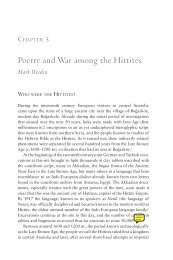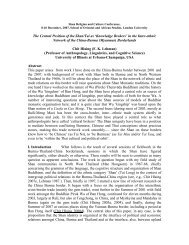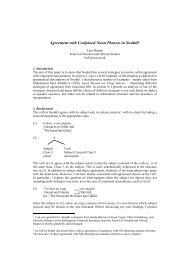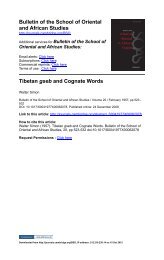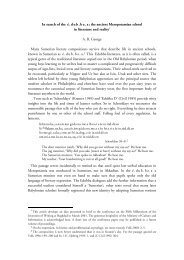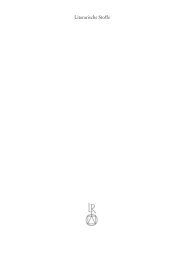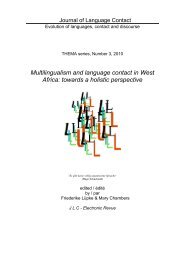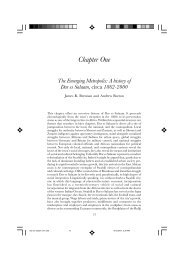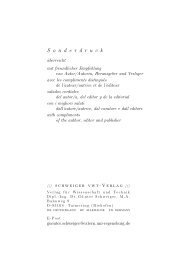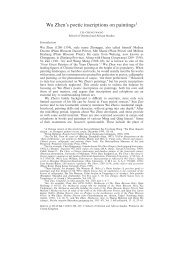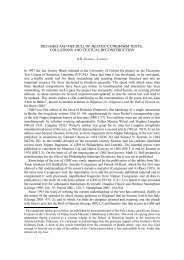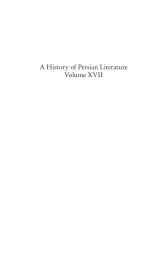Download (6Mb) - SOAS Research Online
Download (6Mb) - SOAS Research Online
Download (6Mb) - SOAS Research Online
Create successful ePaper yourself
Turn your PDF publications into a flip-book with our unique Google optimized e-Paper software.
CONTENTS<br />
KURT TROPPER & CRISTINA SCHERRER-SCHAUB<br />
(Vienna/Lausanne/palis )-Preface ...................... ................. vii<br />
KUNSANG NAMGYAL LAMA (Paris)-Tsha tsha<br />
inscriptions: a preliminary survey ........................................... 1<br />
KURT TROPPER (Viemla)-The Buddha-vita in<br />
the White Temple of Tsaparang ............................. ... ....... ... .43<br />
BENJAMIN WOOD (Victoria)-Misbehaviour and<br />
punishment in a paper inscliption at Zha lu<br />
monastery: a preliminary report. .... .. ... ...................... .. ........ 107<br />
CRISTINA SCHERRER-SCHAUB (Lausanne/Parisl<br />
Vienna)-Classifying, questioning and<br />
interpreting Tibetan inscliptions .......................................... 139<br />
NATHAN W. HILL (London)- A new interpretation<br />
of the mythological incipit of the Rkong po<br />
inscription ..................................................................... 171<br />
INDEX .... ... ......... ..... ....... ..... ... ........................... . . ....... 183
MYTHOLOGICAL 1 CIPIT 175<br />
deeds out of worship for the Lha sras. Because he was not sparing of his<br />
life, (00 .)] (Uebach 1985: 67-68)<br />
As for the elder brother, Kar-po, when he first came from above he made<br />
offerings to the powerful sku-bla of the two brothers; and the god begotten<br />
with the sku-bIa De-mo assumed control (over Kar-po). Nevertheless,<br />
for the honor of the son of the Gods he (Kar-po) took such steps that (it<br />
even came down to his own life:) even his own life was jeopardized; and<br />
he did not show concern for his life. (Li & Coblin 1987: 205)<br />
gcen nya khyi ste rkong ,:je kar po ni / thog 111a rgyal po'i khri la phebs<br />
pa 'i tshe / sras sku mched gnyis kyi rus Iha gnyan po gsol ba dang / rus<br />
lha de 117,0 dang khyin'l thab byas / te rus Iha 'i bdag po byas pa 111a zad /<br />
btsan po lha sras sha khyi'i sku'i rim gro 'i ched rang nyid kyi srog fa thug<br />
pa man chad kyi cho ga gang yod bsgrubs shing rang srog phangs med<br />
zhus ( .. . )<br />
[The older brother Nya khyi, who was the Kar po lord of Rkong po,<br />
when first he ascended to the throne of kingship, he made offerings to the<br />
powerful ancestral god of the sons, the two brothers. Having established<br />
a family with the ancestral goddess De mo, not only did he serve as lord<br />
of the ancestral god, for the sake of the rim gro of the body of the emperor,<br />
the divine son Sha khyi, he performed any ceremonies until it<br />
touched upon his own life, and he was not sparing of his own life ( ... )]<br />
(Bkra shis zla ba 2004: 16)<br />
That elder brother [i.e., Sha Khyi] was (then) Kar-po; when first he came<br />
from above (yas), even though he acted as a Iha bdag who made the sku<br />
bla gnyan po gsol ba of the two brothers and mated with the Sku Bla Demo,<br />
he (further) performed ritual service for the sku of the Lha Sras and<br />
perfoI111ed rites to the point that they became a threat to his own life. As<br />
he did not spare his own welfare, ( ... ) (Walter 2009: 101 , brackets in<br />
original)<br />
All previous researchers except Walter regard the Kar po as the same<br />
figure as the older brother from central Tibet, Nya khyi. Macdonald,<br />
Richardson (1985), Chen & Wang (1984, 2003), Uebach, and Bkra<br />
shis zla ba identify Nya khyi with the Kar po in their translations. The<br />
translation of Richardson (1972) and Li & Coblin (1987) are agnostic<br />
on this point, but in their commentaries this identification is made explicitly<br />
(Richardson 1972: 38; Li & Coblin 1987: 211,215). Walter"s<br />
apparent identification of the Kar po with Sha khyi must simply be a<br />
mistake, since Nya khyi is explicitly named as the older son of Dri<br />
gum.
MYTHOLOGICAL I CIPIT 177<br />
lines earlier, referring as it does across Old Tibetan literature to the<br />
progenitor of the Spu rgyal dynasty whether his name be Spu de<br />
Gung rgya, ya(g) Khri btsan po, or '0 De spu rgya1.<br />
The context for the retelling of this narrative must be borne in<br />
mind; it serves as the prologue to a request for tax relief by the current<br />
ruler of Rkong po to the reigning Tibetan emperor. The point<br />
rhetorically is to remind the emperor of the degree to which the ancestors<br />
of the ruler of Rkong po aided the ancestors of the Tibetan<br />
emperors when the latter had fallen on hard times, and to relnind<br />
hin1 of how loyal the rulers of Rkong po have always remained to the<br />
imperial family since. The meaning of "kar po ... yas gshegs" is that<br />
the king of Rkong po has a pedigree which is just as divine as that of<br />
the Tibetan emperor. Seen in this light, the fact that the divinely sent<br />
Kar po chooses not only to host the two, now unfortunately mortal,<br />
central Tibetan refugees, but also accepts them as overlords, pOltrays<br />
Rkong po as mythologically independently legitimate of and extremely<br />
gracious toward the Spu rgyal dynasty. In contrast, the story<br />
of an older son choosing to settle in a far flung territory and doing his<br />
best to maintain family traditions there packs much less punch in the<br />
rhetorical context of a petition by the ruler of Rkong po to the Tibetan<br />
throne.<br />
This story broadly parallels the tale told in the first chapter of the<br />
Old Tibetan Chronicle (PT 1287) which explicitly equates the brother<br />
Nya khyi with the Rkong po Kar po (n.va khyi ni rkong dkar po lag so,<br />
1. 51). This evidence may have been what predisposed other investigators<br />
to see Nya khyi and the Kar po as the same person also in the<br />
Rkong po inscription. However, as is clear from another detail the<br />
two accounts are not identical stories. In the Rkong po inscription<br />
Nya khyi is the older brother and Sha khyi the younger, whereas in<br />
the Old Tibetan Chronicle these roles are reversed. Because of tIllS<br />
difference, there is no reason to believe that the story in the Old<br />
Tibetan Chronicle is a reliable guide to the interpretation of the<br />
Rkong po inscription. The fact that Nya khyi becOlnes king of Rkong<br />
po in the Old Tibetan Chronicle's version in no way undermines the<br />
reasons for believing this is not the case in the Rkong po inscription.<br />
1O<br />
10 Both versions have Nya khyi remain in the region of Rkong po. By implication<br />
in the Old Tibetan Chrollirle it is Sha khyi who returns to Phying ba stag rtse and restores<br />
the dynasty. but his name is not mentioned explicitly ,at this juncture. At the
MYTHOLOGICAL 1 CIPIT 179<br />
rection can be inferred from the two attested rections ("male<br />
[associative] female-[absolutive]" and "female-[associative] with the<br />
male supplied by context").<br />
The correct analysis treats the Kar po as the agent of bgyid, and<br />
the words lha bdag together as the noun phrase patient of bgyid. If<br />
one were to concur with those translators who opt to regard sku bla<br />
de mo as one noun phrase, this leads inevitably to the conclusion that<br />
the Kar po is the anaphorically provided agent of bshos. None of the<br />
translations which take this premise follow through with this inevitable<br />
conclusion, perhaps because it could easily lead to the unacceptable<br />
result that the Kar po worships his own son. Walter draws<br />
attention to the result of this reading that a human being, the Kar po,<br />
would have copulated with a deity, sku bla de mo. This is exactly how<br />
Bkra shis zla ba understands the passage. However, Walter (2009:<br />
102) notes that such a match is unprecedented in Tibetan literature.<br />
His solution to this enigma is to suggest that sku bla are human<br />
beings and not divinities. A simpler and philologically superior solution<br />
is to construe sku bla and de 7110 as separate noun phrases.<br />
Although Uebach's analysis relies on the likely but unproven premise<br />
that the verb bshos has the rection "male-(absolutive) female<br />
(associative)", because all other translations so far provided are grammatically<br />
impossible, the burden lies with those who wish to see sku<br />
bla de rrw as one noun phrase to demonstrate a grammatically feasible<br />
analysis of the text consistent with such a premise.<br />
Depending on the meaning of the phrase lha bdag the modifier sku<br />
bla de 7110 dang bshos pa'i "engendered by the sku bla with De mo"<br />
can either modify lha alone or the entire noun phrase lha bdag. The<br />
string of Tibetan letters transliterated bdag is generally understood to<br />
be able to refer to three words 'l/me', 'self', and 'ruler/lord'. The<br />
interpretation of the word in this context can be resolved with reference<br />
to a parallel passage Karmay draws attention to in the Ge khod<br />
bsang ba'i dkar tshan (a section of the Ge khod gsang ba drag chen,<br />
cf. Anon 1973), where the phrase lha bdag 'lord of the god' is a<br />
technical term of ritual: "lha dang lha bdag mjal ba 'i phyir / -;,hal gyi<br />
mchil ma Uags gang la / bdud rtsi small du SlnOll lam btab" (Kannay<br />
1998: 409,1. 23) [She prayed a full tongue of spittle from the mouth<br />
as medicinal ambrosia in order that the god should meet the god
l S2 1 ATHAN W. HILL<br />
Macdonald, A. 1971. Une lecture des P.T. 1286, In7, 1038, 1047, et 1290. E ssai sur<br />
1



